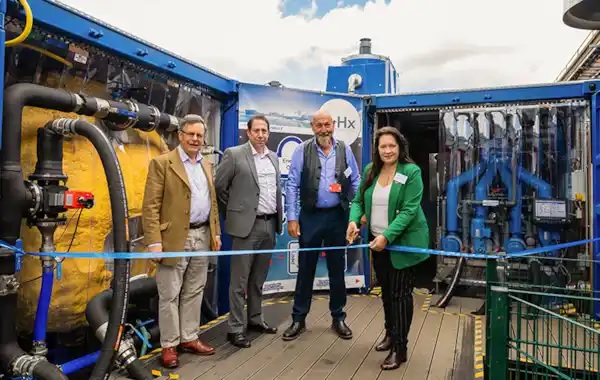More than 50 guests attended an open day to showcase the potential of the pioneering EnergiVault energy storage solution, created to support the decarbonisation of cooling and deliver cost savings for industrial processes and commercial buildings.
Generally, for product launches, if you offer free alcohol, canapes, somewhere salubrious in London on a Thursday night, people will flock to the opening of a fridge. Organic Heat Exchangers reversed this and launched EnergiVault (Cool Net Zero), on a Monday, in Alwick (100 miles from Edinburgh), with no alcohol, during the day, and amazingly, achieved a full house including many members of the press who had travelled 200 miles. It now has to be accepted that EnergiVault is a gamechanger. Its also patented around the world.
The patented cold thermal energy storage (CTES) system from Lancashire-based Organic Heat Exchangers (O-Hx) is undergoing full working trials at the Alnwick site of Quotient Sciences, a drug development and manufacturing accelerator, and has already delivered significant benefits and savings after being installed alongside an existing chilled water system.
EnergiVault consists of a charger, powered by a Bitzer compressor, and thermal battery. The charger’s ice crystallisers charge the battery by converting up to 60% of the system’s heat transfer fluid (HTF), a water/glycol mix, into spherical ice crystals a fraction of a millimetre in diameter, each surrounded by a film of organic material. This ice slurry acts as the phase change material (PCM), resulting in a massive increase of the surface area over which the thermal transfer takes place. The thermal battery has very high discharge rates, unlike solid ice technologies, and unlimited charge-discharge cycles with zero battery degradation.
The system’s cloud-based optimisation engine ensures peak savings in electricity and carbon. The battery is charged using off-peak electricity, or locally generated renewable power, and then drawn down for use during high-tariff periods. Time of use (ToU) shifting is one of the scalable control strategies which allow integration with existing systems and live external data, enabling chiller optimisation and high and low heat grade heat recovery. The optimisation engine also enables the system to take advantage of periods of low carbon intensity on the grid, when more of the power is produced from renewable sources, resulting in reduced impact on the environment.
Operating data from the trial reveals that EnergiVault will handle 30% of the Quotient Sciences site’s 500MWh per year cooling demand at a basic level of operation, utilising ToU shifting to avoid high electrical tariffs. This has resulted in a 27% cost saving to date through load shifting and chiller efficiency benefits. When operating at its full potential, O-Hx calculates that savings significantly in excess of this will be available for the majority of sites, with potential for more than 60% saving against site cooling costs and reduction of CO₂ emissions.
